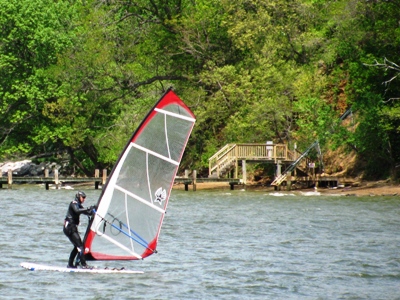
The Severn River flows through central Maryland, reaching the Chesapeake Bay near Annapolis. The primary source of freshwater is the Severn Run. Downstream, the river is fed by a number of smaller tributaries and coves.
The Severn River is recognized as a Maryland Scenic River. Along its path, the river passes through a mix of woodlands, agricultural areas, grassy areas, marshes, and swamps.
Among its many habitats is one of the few remaining stands of Atlantic White Cedar on Maryland’s western shore. Along its lower sections, submerged aquatic vegetation has returned in some areas.
More than 1,700 acres of the Severn Run watershed are protected by Maryland as a preserve designated the Severn Run Natural Environment Area.
Much of the Severn River Watershed is impacted by human development. According to a Maryland Department of Natural Resources study, impervious surfaces now occupy nearly 20 percent of its suburban watershed.
Research suggests that the decline of yellow perch in the Severn is due in part to extensive urban development, rising salinity levels in the upper river’s nursery habitats, and other factors. The Severn River Waterkeeper has documented multiple instances of hypoxic zones (dead zones) in the river.
In 2010, the Maryland Department of the Environment (MDE) investigated a large fish kill that included white perch, bay anchovy, menhaden, Atlantic needlefish, and other species. An algae bloom was listed as a contributing factor in the kill.
Severn River Fishing
The Severn River sustains a saltwater fishery and, to a lesser extent, a freshwater environment. Much of the fishing occurs in the tidal Severn, where white perch is by far the most common species of fish. Anglers fishing in the tidal Severn also catch striped bass, croakers, spot, and other saltwater species.
Farther up river, near Severn Run, anglers fish for a mix of freshwater and anadromous species including chain pickerel, white perch, carp, and others. Jabez Branch is said to contain one of the few remaining wild populations of brook trout in Maryland.
Because of its unique habitats and mix of species, fishermen often employ specialized fishing techniques. Jigs, spinnerbaits, spoons, inline spinners, and other small, flashy lures are extremely popular throughout the river. These types of lures seem to produce, even in low-visibility water. White, chartreuse, yellow, and pink are known to be effective colors in the Severn.
Anglers using these lures report fishing success in a number of areas throughout the Severn River. White perch are often found around submerged structure, along drop offs, in current rips, and along the shoreline. The same lures and techniques that produce fish in the tidal river can also be utilized to catch chain pickerel and white perch in the Severn River’s upper reaches.
One of the more interesting fishing areas is the Severn River Artificial Reef. Located near 38°59.63 North 076°29.07 West. The reef, which lies in 15-30 feet of water, consists primarily of remnants from the old Route 2 bridge.
Recreation
The Severn River is a popular location for a variety of water sports, including pleasure boating, sailing, water skiing, sailboarding, kayaking, and other activities.
The area near the river’s mouth often bustles with a mix of fishing boats, sailboats, tours, and other activity. The U.S. Naval academy, nearby bluffs, and Chesapeake Bay Bridge all combine to provide a stunning backdrops for boating.
Just minutes from downtown Annapolis, Jonas Green Park provides access to the Severn River. Adjacent is the Severn River Fishing Pier, a portion of the old rt. 2 bridge.